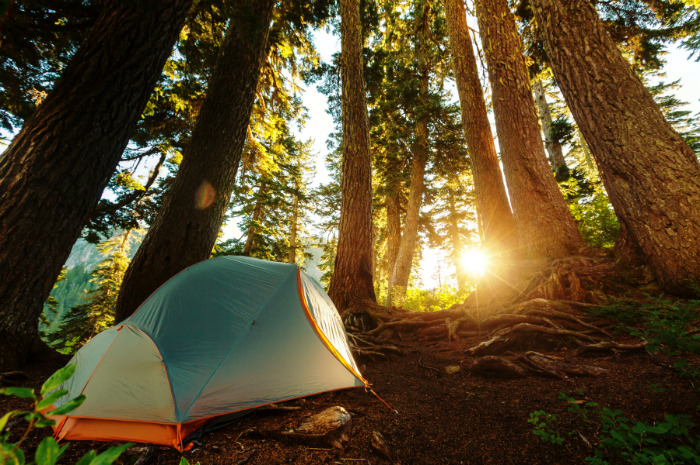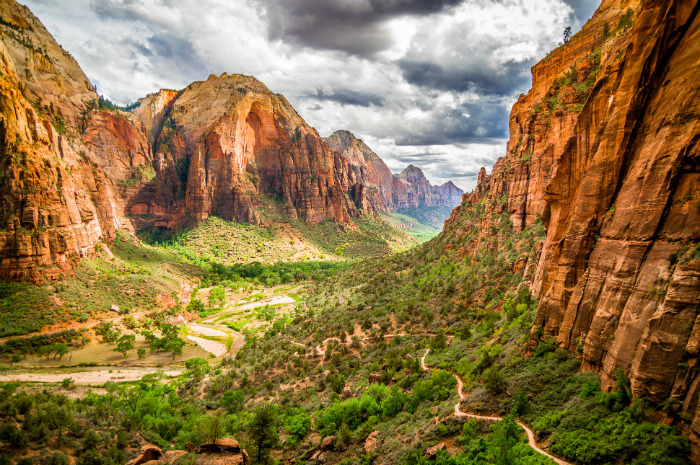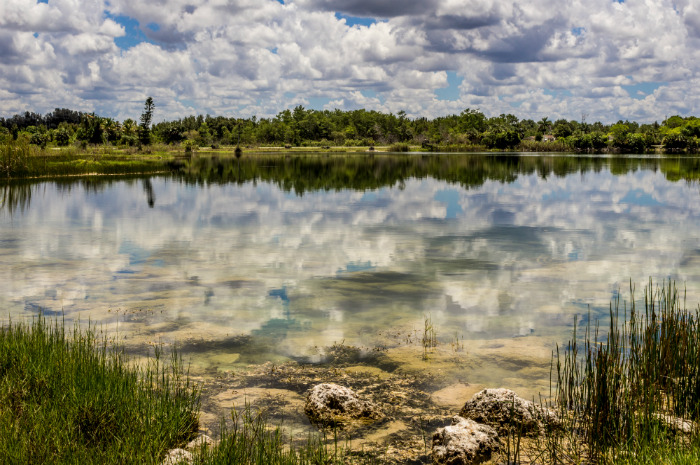Best National Parks For Camping In The Spring
Now that spring is here and the days are longer, you can finally stop hibernating and reconnect with nature.
Recent studies have shown that merely a walk in the park can calm the mind while changing the way the brain works in ways that improve mental health. According to science, people who spend time in parks cope better with stress, feel happier and have more self-esteem.
Are you itching to get out of the house already? Why not spend a few days camping in one of America's 58 national parks, which are celebrating a centenary this year? During National Park Week, ending on April 24, every park is free.
Recharge your mind and body with stunning views of wild nature, breathtaking waterfalls, majestic lakes and rivers, red rock landscapes, lavish forests, tall rocky spires and cliffs, to name a few.
1. Great Smoky Mountains in North Carolina and Tennessee
Deep Creek Campground is an awesome place to stay for a few days. It's all about the water. This 92-site campground is ideal for all kinds of freshwater activities, some of which are more intense than your usual workout. Also, you are very close to Juney Whank Falls, Tom Branch Falls, Indian Creek Falls. The stunning views make for perfect day hikes. The more adventurous campers can set up at horse camps. They offer hitch racks for horses and primitive camping facilities.
2. Yellowstone National Park in Wyoming, Montana and Idaho
You just can't get enough of Yellowstone National Park in one day; you have to stay several nights as well to experience its adventures. There are 12 camps, some of which require reservations. Slough Creek Campground is among the quitter ones – it's hidden about two miles down an unpaved road in the Lamar Valley. Fly-fishermen love it. The place is also ideal for wildlife watching. Fishing Bridge RV Park is the only campground offering water, sewer, and electrical hookups-50 amp service; it is for hard-sided vehicles only.
3. Rocky Mountains National Park in Colorado
Moraine Park Campground is the only one open year-round. The others will open in late May or in the summer. The camp, which is also one of the more popular wildlife-viewing spots in the region, offers some of the best sights of the park, famous for its high peaks and pine forests. Mule deer and elk are a regular presence. You may also get a chance to encounter coyotes, black bears (this is how to survive an attack), bighorn sheep and moose.
4. Denali National Park in Alaska
Denali is the highest mountain in North America, peaking at 20,320 feet. That alone is a reason to explore what it can offer (climbing it is a must). Camping at Wonder Lake is one of the best spots for stunning views of the snow-covered hills. Beavers, moose and possibly grizzly bears may be in the vicinity when you go hiking (learn some safety tips). Technically, you have about six million acres of open land to travel through and enjoy. You are allowed to camp a total of 14 days per year in Denali's six campgrounds.
5. Yosemite National Park in California
If you have an RV and want to go on a long camping trip (you may need these essentials), Yosemite is your destination. It has 13 popular campgrounds. Reservations are recommended for many of them, especially if you plan to go between May and September. You won't see cars or roads in most of the park. Go on a hiking trip to Glacier Point for a stunning view of the famed Yosemite Valley and Half Dome, which is one of the most dangerous places in the region.
6. Arches National Park in Utah
All 50 sites in Arches' campground, Devils Garden, are usually reserved in advance during the busy season, which is March through October, according to NPS. There are no showers and you have to bring your own wood or charcoal for the grills. But the views of this red rock wonderland, which makes for one of the best road trips in the country, and the range of activities among the thousands of natural stone arches are worth every bit of inconvenience. Hiking, rafting, mountain biking (here's why you should try it), rock climbing (you should master these skills) are a few options.
7. Glacier National Park in Montana
Glacier National Park is not your average camping destination. You have about a million acres at your disposal and plenty of chances to go deep into the backcountry (don't forget these accessories). Weeks of exploring the unmarked trails, some of which are remote and hidden, won't be enough. With 13 different campgrounds and more than 1,000 sites to choose from, options are abundant. Most campgrounds are first-come first-served with the exception of Fish Creek, according to NPS.
8. Bryce Canyon National Park in Utah
Imagine waking up and the first thing you see are the hoodoos, tall rocky spires. It's a stunning view. But this is not all Bryce Canyon National Park offers. The park reaches 2,000 feet. At some point you may feel you are in a completely different park – there are separate ranges with spruce, Ponderosa and Pinyon pines. Some hiking trails can be easily handled by beginners. All sites in the two campgrounds are limited to 10 people.
9. Voyageurs National Park in Minnesota
The Voyageurs National Park is not the most famous place for camping because most campsites are quite remote. You will actually need a boat to reach them. So if you're looking for peace of mind, isolated camping and a copious number of water activities, consider this park. If you don't have your own vessel, go on a guided boat tour to see the natural beauty of the park. Backcountry camping is also permitted anywhere in the park.
10. Joshua Tree National Park in California
Joshua Tree National Park is the right choice for adventurers who really want to connect with nature and the wilderness. Imagine sleeping directly under the starry night sky and witness some of the most stunning nighttime views in the Golden State? There are nine different campgrounds offering about 500 developed campsites all suitable for people traveling alone or with big families, the NPS says. Campgrounds usually fill on weekend nights from October through May. Most sites are first-come, first-served.
11. Olympic National Park in Washington
Kalaloch is the only campground that accepts reservations in the summer. All other campgrounds are first-come, first-served, according to NPS. Consider camping at Deer Park, which boasts mountain views worth the climb and starry skies like few other places since it's at 5,400 feet in elevation. If you want to experience secluded tenting, Dosewallips Campground is your spot. Go hiking and explore the rugged glacier-capped mountains, wild Pacific coast, or lavish rainforest.
12. Zion National Park in Utah
Zion National Park has three campgrounds. South and Watchman Campgrounds, where reservations are recommended, are in Zion Canyon. The Lava Point Campground is about one-hour drive from Zion Canyon on the Kolob Terrace Road, according to NPS. Zion has become an increasingly popular place to pitch a tent as campsites usually fill up by noon. Mid-March through November is the park's busiest time.
13. Big Bend National Park in Texas
Big Bend visitors can choose from three frontcountry, NPS-operated campgrounds. Chisos Basin is described as being surrounded by tall, scary cliffs and is a prime spot as it's situated close to many of the park's most popular trails. The Cottonwood Campground is characterized as more of a serene and shady site, while the Rio Grande Village Campground, adjacent to the Rio Grande, offers a camp store and showers within walking distance, as well as an RV campground with full hook-ups.
14. Everglades National Park, Florida
There are two drive-in campgrounds accessible from the Homestead entrance of the park: Long Pine Key Campground and Flamingo Campground, according to NPS. Both accommodate tents and RVs. Hiking, biking, canoeing and kayaking opportunities in the huge park of more than 2,400 square miles will keep you entertained. In fact, you may have to use one of these options to reach most backcountry camping sites. Be on the lookout for manatees, alligators and crocodiles.
15. Shenandoah National Park, Virginia
There are four campgrounds in Shenandoah National Park but most of the park, including its wilderness, is open to backcountry camping (for which you need a permit). You have 196,000 acres of backcountry and wilderness and over 500 miles of trails to explore, according to NPS.

.jpg)
.jpg)
.jpg)
.jpg)
.jpg)
.jpg)
.jpg)
.jpg)
.jpg)
.jpg)
.jpg)

.jpg)

.jpg)